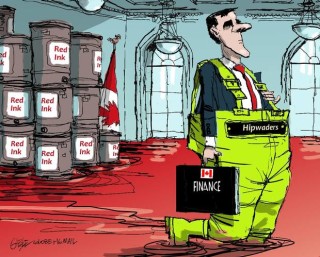Ontario has tabled a two-track budget, touting $130-billion in new transit and other infrastructure over the next decade while simultaneously imposing tough austerity on health care and education in a bid to wrestle down the deficit.
It is a blueprint to fulfill Premier Kathleen Wynne’s plan to vastly expand the province’s out-of-date transportation system, while also putting its fiscal house in order and dealing with the largest subsovereign debt in the world.
The spending plan projects a deficit of $8.5-billion, down $2.4-billion from last year, and pledges to balance the books in two years. To get there, the province is freezing base operating funding to hospitals, pushing boards to close underused schools and taking a hard line in labour negotiations, among other measures.
“Ontario has now been able to cut its spending, I should say, to improve its savings targets throughout,” Finance Minister Charles Sousa told reporters in a news conference Thursday before delivering the budget in the legislature. “And that has enabled us to find greater success.”
Program spending will rise just 1.4 per cent this year and 0.8 per cent next year, before a 0.5-per-cent cut in 2017.
Much of the Liberals’ plan involves holding the line on funding for hospitals, school boards and other sectors – effectively compelling them to cut costs or find efficiencies. Hospitals have already shed registered-nurse jobs, while social agencies have cut their hours or made staff take unpaid days off. Some cities, grappling with the province’s rejigging of their funding formula, have cut back on daycares and other services.
The government is playing hardball with the unions, demanding they accept “net zero” deals, in which any pay increases are offset by cuts elsewhere. The province has had some success, negotiating a contract that froze the pay of some civil servants for two years. It also imposed a cut to doctors’ fees this year, over the objections of the Ontario Medical Association.
The budget also projects that a program review led by Deputy Premier Deb Matthews will find $500-million in savings across government. In this task, she will be helped by two newly created agencies – the Centre of Excellence for Evidence-Based Decision Making Support and the Behavioural Insights Unit – specifically formed for the purpose of finding places to save money.
The government is, however, ramping up spending in one key area. The budget promises funding for a laundry list of transit projects, including more frequent, electrified trains on parts of the GO regional rail network and a light-rail line in Mississauga and Brampton.
Mr. Sousa characterized transit construction as the central infrastructure challenge of the 21st century, noting that congestion was choking the province’s economy – particularly in Toronto and its sprawling suburbs – and compared it to Sir John A. Macdonald’s building of the railway in the 1800s.
“We can’t afford any more delays. We must build,” he told the legislature in his budget speech. “All of this supports a strong economy – with growth and jobs.”
A portion of the funds for this construction will come from privatizing Hydro One and selling off pieces of government-owned land, as well as the government’s shares in General Motors.
Immediate reaction to the budget was split. While everyone from municipal politicians to business leaders lauded the infrastructure promises, public-sector unions warned that the spending cuts would hurt front-line services.
The Progressive Conservatives argued that the fiscal plan, despite its many austerity measures, did not cut deep enough.
“This Liberal government continues to have an addiction to spending,” interim leader Jim Wilson told reporters. “Ontario can’t afford this budget.”
New Democrat Leader Andrea Horwath, meanwhile, called on the government to reverse corporate tax breaks instead of clawing back spending.
“Ontarians didn’t vote for this,” she said. “This budget cuts education and closes schools, cuts health care and fires nurses, it cuts poverty-reduction programs and sells off our hydro system to Bay Street.”
ADRIAN MORROW
TORONTO — The Globe and Mail
Published Thursday, Apr. 23 2015, 4:06 PM EDT
Last updated Thursday, Apr. 23 2015, 10:17 PM EDT

